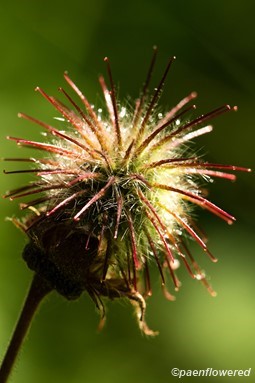Geum rivale
Geum rivale water avens
Water avens (Geum rivale) is another native member of the rose family (Rosaceae) in the Great Lakes states and the Northeast as well as the Rocky Mountains, much of Canada and the temperate regions of Eurasia. It prefers wetlands with full or partial sun including slow-draining bogs, fens, pond edges, deciduous swamps, stream or river sides and wet meadows. It can hybridize with its close relative, Geum urbanum, as well as two other Geum species.
The half-inch, initially-nodding flowers have five yellowish petals mostly hidden under purple or maroon sepals that form the enclosing calyx. The flowers are set up to be pollinated mainly by bees but also flies and beetles. As a last resort it will self-pollinate. Water avens has a long-flowering period, usually May to August. The main flowering period is May and June followed by sporadic rebloomings. The resulting burr-like seeds get caught in the fur of rabbits and small mammals who do the job of dispersal. Rhizomal growth can maintain a colony and sometimes leads to dense clusters but expansion is otherwise limited with this method.
If you boil the rhizomes, the tea has a faint taste of chocolate, hence another common name for the plant, "chocolate root". Native Americans used it medicinally to treat coughs and colds in children as well as dysentery and other ailments of the digestive tract and malaria. This led to the folk-name "Indian chocolate". Unlike the roots, the leaves are mildly bitter due to the presence of tannins.
The large, compound basal leaves have heavily-toothed leaflets ranging in size from a small lateral pair toward the bottom, medium in the middle and finally a single, large, often-lobed terminal leaflet. These are interspersed with tiny leaflets along the main leaf stem (rachis). Each flower stem arises from the axil of an upper leaf which can be sharply-lobed or palmately compound with three points.
Habitat & Range
Occasional in bogs, peaty meadows and marshes.
See distribution map at BONAP.
| EMP: | OBL |
|---|---|
| NCNE: | OBL |
Phenology
Flowers May & June with sporadic rebloomings later on.
Plant Codes
S-rank: No Rank
G-rank: G5 (Secure)







Comments
Have you spotted this plant in your area? We'd love to hear about your experience! Share your comments or questions about the plant below. Comments are moderated before posting.